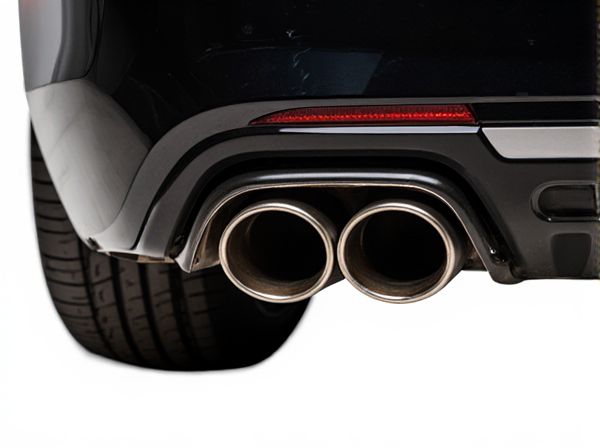
Photo illustration: H-pipe vs X-pipe
H-pipes and X-pipes both improve exhaust flow and performance by balancing pressure between exhaust manifolds, but they differ in design and sound. An H-pipe typically produces a deeper, more traditional muscle car tone with enhanced low-end torque, while an X-pipe offers a smoother, higher-pitched sound and can increase horsepower at higher RPMs. Choosing the right pipe depends on your performance goals and the sound profile you prefer for your vehicle.
Table of Comparison
| Feature | H-Pipe | X-Pipe |
|---|---|---|
| Design | H-shaped crossover connecting exhaust pipes | X-shaped crossover merging exhaust flows |
| Exhaust Flow | Balances exhaust pulses, maintains backpressure | Improves scavenging, reduces backpressure |
| Performance Impact | Enhances low-end torque and fuel efficiency | Increases high-end horsepower and top-end power |
| Sound Characteristics | Deep, traditional muscle car rumble | Smoother, higher-pitched exhaust tone |
| Best Use | Street cars, vehicles prioritizing torque | Racing, performance-focused vehicles |
| Cost & Complexity | Simple to install, generally less expensive | More complex design, higher cost |
Introduction to Exhaust Pipe Configurations
H-pipe and X-pipe exhaust configurations both enhance performance by balancing exhaust pulses for improved scavenging and power output. An H-pipe connects the exhaust tubes with a horizontal crossover, promoting better low-end torque and a deeper sound, while an X-pipe uses a crossover shaped like the letter "X" to optimize exhaust flow, resulting in increased horsepower and a smoother, higher-pitched tone. Choosing between H-pipe and X-pipe depends on desired sound characteristics and performance goals, with H-pipes favoring torque and X-pipes maximizing top-end power.
What is an H-Pipe?
An H-pipe is an exhaust system design featuring a single crosspipe that connects two exhaust pipes, resembling the letter "H." This configuration balances exhaust pressure between both sides of a V-type engine, improving scavenging and enhancing low-end torque and drivability. Typically, H-pipes produce a deeper, more traditional muscle car sound compared to the sharper tone of an X-pipe.
What is an X-Pipe?
An X-pipe is a type of exhaust system component designed to improve exhaust flow and enhance engine performance by merging two exhaust pipes at a central crossover point in an "X" shape. This design helps equalize exhaust pulses from both sides of a V-engine, reducing backpressure and promoting smoother scavenging, which increases horsepower and torque. Compared to an H-pipe, an X-pipe typically offers a higher-performance sound with a slight increase in exhaust gas velocity.
H-Pipe Design and Functionality
The H-pipe design incorporates a transverse pipe connecting two exhaust pipes, promoting equalized exhaust pressure and enhanced scavenging for improved torque at low to mid RPMs. This design smooths exhaust pulses by balancing flow between both banks, reducing backpressure and boosting overall engine efficiency. Its functionality excels in street and performance vehicles seeking better throttle response and low-end power without sacrificing sound quality.
X-Pipe Design and Functionality
The X-pipe design features a crossover where two pipes intersect forming an "X" shape, enhancing exhaust gas flow by balancing pressure waves between the cylinder banks. This design reduces backpressure and promotes scavenging, resulting in improved engine efficiency, increased horsepower, and a smoother exhaust note. Compared to H-pipes, X-pipes excel in high-performance applications by optimizing exhaust pulse merging and minimizing turbulence for better overall performance.
Performance Differences: H-Pipe vs X-Pipe
H-pipe and X-pipe designs both balance exhaust flow but influence performance distinctly; H-pipes typically enhance low-end torque by promoting exhaust scavenging and pressure equalization between exhaust banks, which improves throttle response and drivability. X-pipes excel at maximizing horsepower at higher RPMs by facilitating smoother exhaust gas crossover, reducing backpressure, and increasing scavenging efficiency. Selecting between the two depends on desired engine characteristics: H-pipes favor torque and midrange power, while X-pipes boost peak horsepower and high-RPM performance.
Sound Characteristics Comparison
H-pipe exhaust systems produce a deep, throaty tone with more low-end rumble due to the pressure equalization between the dual exhaust pipes. X-pipe configurations generate a smoother, higher-pitched sound by promoting better exhaust scavenging and reducing backpressure. The H-pipe emphasizes traditional muscle car growl, while the X-pipe delivers a refined, high-performance exhaust note favored in sports cars.
Installation Considerations
H-pipe and X-pipe installations require careful alignment with existing exhaust system components to ensure optimal fit and performance. H-pipes are generally easier to install due to their simpler design and fewer welding points, making them ideal for stock or near-stock setups. X-pipes demand precise positioning and often custom modifications to achieve proper balance and exhaust flow, especially in high-performance applications.
Best Applications for H-Pipes
H-pipes are best applied in V8 engine setups where enhanced mid-range torque and balanced exhaust flow are desired, making them ideal for muscle cars and street performance vehicles. Their design minimizes exhaust drone and improves scavenging between cylinder banks without sacrificing low-end power. Compared to X-pipes, H-pipes provide a deeper, more traditional sound suited for vehicles aiming to retain a classic muscle car exhaust tone.
Best Applications for X-Pipes
X-pipes are best suited for performance exhaust systems where maximizing horsepower and torque is a priority, commonly used in muscle cars and high-performance vehicles. They facilitate efficient exhaust flow by allowing gases to merge and balance between both banks of cylinders, reducing backpressure and enhancing scavenging effects. This design also produces a smoother, less droning exhaust note compared to H-pipes, making X-pipes ideal for street-driven cars requiring improved power and a refined sound profile.
 caratoz.com
caratoz.com